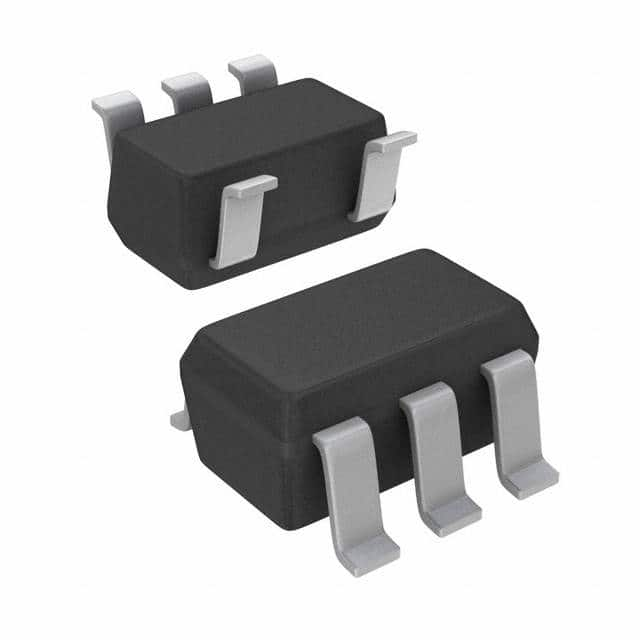SN74LVC1G02DBVTG4
Product Overview
- Category: Integrated Circuit (IC)
- Use: Logic Gate
- Characteristics: Single 2-Input NOR Gate
- Package: SOT-23-5
- Essence: Digital Logic Component
- Packaging/Quantity: Tape and Reel, 3000 pieces per reel
Specifications
- Supply Voltage Range: 1.65V to 5.5V
- Input Voltage Range: 0V to VCC
- Output Voltage Range: 0V to VCC
- Operating Temperature Range: -40°C to +125°C
- Propagation Delay: 3.8ns (typical) at 3.3V
- Maximum Quiescent Current: 1µA at 5.5V
- Maximum Output Current: ±32mA
Detailed Pin Configuration
The SN74LVC1G02DBVTG4 has a total of 5 pins arranged as follows:
____
Y ---| |
A ---| |
B ---| |
GND ---| |
VCC ---|____|
Functional Features
- Single 2-Input NOR gate with open-drain output
- High-speed operation with low power consumption
- Compatible with both CMOS and TTL input levels
- Schmitt-trigger input allows for noisy signal rejection
- Supports mixed-mode voltage operation
Advantages and Disadvantages
Advantages: - Small package size enables space-saving designs - Low power consumption extends battery life in portable devices - Wide supply voltage range allows for versatile applications - Compatibility with different logic families simplifies integration
Disadvantages: - Limited number of inputs (only 2) - Open-drain output may require additional pull-up resistor - Propagation delay may affect timing-sensitive applications
Working Principles
The SN74LVC1G02DBVTG4 is a digital logic component that implements the NOR gate function. It takes two input signals, A and B, and produces an output signal, Y, according to the truth table of a NOR gate. The open-drain output allows for wired-OR configurations by connecting multiple outputs together.
The gate operates based on the principles of complementary metal-oxide-semiconductor (CMOS) technology. It utilizes transistors to perform logical operations, providing high-speed performance with low power consumption.
Detailed Application Field Plans
The SN74LVC1G02DBVTG4 can be used in various applications, including but not limited to: - Microcontrollers and microprocessors - Data communication systems - Industrial automation - Automotive electronics - Consumer electronics - Medical devices
Its small package size and low power consumption make it suitable for portable and battery-powered devices. The compatibility with different logic families allows for seamless integration into existing systems.
Detailed and Complete Alternative Models
Some alternative models that provide similar functionality to the SN74LVC1G02DBVTG4 include: - 74HC02: Quad 2-Input NOR Gate - CD4001: Quad 2-Input NOR Gate - MC14093: Quad 2-Input NAND Gate with Schmitt Trigger Inputs - SN74LVC1G00: Single 2-Input NAND Gate
These alternatives offer different package options, voltage ranges, and additional features, providing flexibility in design choices.
In conclusion, the SN74LVC1G02DBVTG4 is a single 2-input NOR gate IC with open-drain output. Its compact size, low power consumption, and wide supply voltage range make it suitable for various digital logic applications. However, designers should consider its limitations, such as the number of inputs and propagation delay, when selecting this component for specific projects.
Senaraikan 10 soalan dan jawapan biasa yang berkaitan dengan aplikasi SN74LVC1G02DBVTG4 dalam penyelesaian teknikal
Sure! Here are 10 common questions and answers related to the application of SN74LVC1G02DBVTG4 in technical solutions:
Q1: What is SN74LVC1G02DBVTG4? A1: SN74LVC1G02DBVTG4 is a single 2-input positive-NOR gate IC (integrated circuit) that is commonly used in digital logic circuits.
Q2: What is the operating voltage range for SN74LVC1G02DBVTG4? A2: The operating voltage range for SN74LVC1G02DBVTG4 is typically between 1.65V and 5.5V.
Q3: What is the maximum output current of SN74LVC1G02DBVTG4? A3: The maximum output current of SN74LVC1G02DBVTG4 is around 32mA.
Q4: Can SN74LVC1G02DBVTG4 be used in battery-powered applications? A4: Yes, SN74LVC1G02DBVTG4 can be used in battery-powered applications as it operates at low voltages and has low power consumption.
Q5: What is the typical propagation delay of SN74LVC1G02DBVTG4? A5: The typical propagation delay of SN74LVC1G02DBVTG4 is around 3.8ns.
Q6: Can SN74LVC1G02DBVTG4 be used in high-speed applications? A6: Yes, SN74LVC1G02DBVTG4 can be used in high-speed applications as it has a fast switching speed.
Q7: Is SN74LVC1G02DBVTG4 compatible with other logic families? A7: Yes, SN74LVC1G02DBVTG4 is compatible with a wide range of logic families, including TTL and CMOS.
Q8: Can SN74LVC1G02DBVTG4 be used in both digital and analog circuits? A8: No, SN74LVC1G02DBVTG4 is specifically designed for digital logic applications and may not be suitable for analog circuits.
Q9: What is the package type for SN74LVC1G02DBVTG4? A9: SN74LVC1G02DBVTG4 is available in a SOT-23-5 package.
Q10: Are there any recommended application circuits for SN74LVC1G02DBVTG4? A10: Yes, the datasheet of SN74LVC1G02DBVTG4 provides recommended application circuits that can be used as a reference for various applications.
Please note that these answers are general and it's always recommended to refer to the specific datasheet and guidelines provided by the manufacturer for accurate information.


